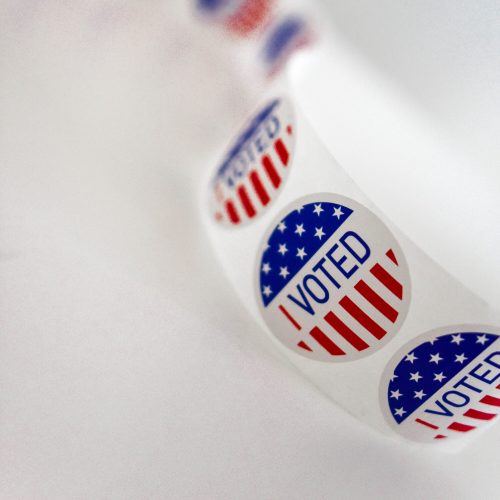
How to: Vote as an American Living Abroad
 Dear Kevin,
Dear Kevin,
Did you know that, according to the Overseas Citizen Population Analysis, less than 5% of Americans living abroad vote in the U.S. Presidential elections? That’s approximately 5 million people whose opinions are not being heard! With the 2020 Presidential Elections quickly approaching, we urge you to get registered to vote from overseas and in this post we’re going to walk you through the steps of how to do that.
Of course, we are familiar with what this process has looked like for us as residents of Spain but this post is for ANYONE who is a citizen of the United States, but who does not currently reside in the U.S.A. It’s interesting to note that the way you register to vote as an overseas U.S. citizen does not vary depending on the country where you currently live, but instead varies depending on the U.S. state in which you last resided. Please note that this post will provide you with the necessary resources to inform yourself, but be sure to follow up on the particular rules that apply to you, based on the U.S. state you are registered to vote in.
Step One: Make sure you’re registered to vote
Before you can embark on the process of registering for an absentee or overseas ballot, it’s important to know if you are already registered to vote—and where you are registered, if you are. Thankfully, there’s a really simple way to answer this question within seconds!
 A quick Google search of “Am I registered to vote?” will direct you to this page on Vote.org where you can enter your name, address, date of birth, and email address to immediately receive:
A quick Google search of “Am I registered to vote?” will direct you to this page on Vote.org where you can enter your name, address, date of birth, and email address to immediately receive:
1.) confirmation that you are correctly registered or
2.) “What do I do now?” instructions if they cannot confirm you are registered.
It’s important to remember that Vote.org uses national voter records, which are not updated as frequently as state records. If you receive a result that they cannot confirm your registration but you feel certain that you should be registered, you have two options:
1.) Proceed to your state’s registration look up page
2.) Try Vote.org’s look up again, but with different information.
It’s essential for all of the information you enter to match up with a voter registration on file. Therefore, if there’s a chance you registered with a different address or surname, it’s a good idea to try again as that’s a likely reason you didn’t receive confirmation.
If, once you have looked up your details through your state’s look up form, you receive the result that your registration status could not be confirmed OR that your registration status is inactive, it’s time to contact your local election authority. Click through the hyperlink on “local election authority” and search from your correct contact point by county. You should find all forms of contact information for the person in charge of your jurisdiction.
Pro-tip: At least in our experience, everyone has been reachable and helpful via email so don’t stress about needing to make international phone calls.
 Step Two: Register to vote or update your voter registration using the FPCA
Step Two: Register to vote or update your voter registration using the FPCA
If you haven’t voted since the last Presidential election, chances are that your status will be “inactive.” Whether you have never been registered to vote before or you simply need to update your information, your local election authority will direct you to file the form known as the FPCA.
You can find this form for yourself online on the Federal Voting Assistance Program website. This site is also useful as a search engine for the particular state guidelines you need to consider. While everyone abroad will need to submit a FPCA to request an overseas ballot, the information required on this form will vary by state.
For example, the FPCA asks for a social security number and a driver’s license / state ID number. Some states require both, some require only one or the other, and some require part of the social security number if you are providing a state ID number, etc. Additionally, question #6 asks YOU “What additional information must you provide?” and so it’s important to add in whatever added details are required by your state here.
You should use the last address you legally resided at as your address on this form. We have confirmed with our local election authority that it is NOT necessary for you to be able to receive mail at this address so don’t worry if you do not know the current residents at that address. This is simply used to register you in the correct jurisdiction. You can read the specifics about your “voting residence” here.
 Step Three: Follow-up to confirm you’re registered
Step Three: Follow-up to confirm you’re registered
At this point, we are on a first name basis with our local election authorities since our email correspondence has been going on weeks. If, like us, you have been in contact with your authority and will submit your FPCA over email, you can ask them directly to update you when your voter registration and/or reactivation has been confirmed.
Alternatively, you can return to step one to confirm this on your own. Keep in mind that one of the reasons the look-up tools may not be able to confirm your registration status is if it was done very recently. For this reason, we recommend giving it a week before you check again and using your state’s look-up page rather than Vote.org’s page.
Step Four: Vote! (Be sure to submit your ballot before the deadline)
 If you properly work through every other step on this list but forget to submit your absentee ballot by the federal deadline, it would be a real shame! Keep in mind that overseas voters are often expected to submit their ballots before the actual election day. According to FVAP’s guidelines, best practice is to return your absentee ballot with your election choices as soon as you receive your ballot—and your state election office should get your ballot to you 45-30 days before the election.
If you properly work through every other step on this list but forget to submit your absentee ballot by the federal deadline, it would be a real shame! Keep in mind that overseas voters are often expected to submit their ballots before the actual election day. According to FVAP’s guidelines, best practice is to return your absentee ballot with your election choices as soon as you receive your ballot—and your state election office should get your ballot to you 45-30 days before the election.
The officially recommended “vote-by day” for overseas citizens, according to FVAP, is October 13, 2020. That being said, the deadline for mail-in ballots is actually Election Day. All votes to be counted for this year’s election must be signed and postmarked by November 3, 2020. If you do wait until Election Day to send in your absentee ballot, however, we highly recommend filling out the FWAB online to submit a “backup ballot” as well.
Frequently Asked Questions:
Can I still register to vote in the 2020 elections?
 If you are reading this before October 4th, you definitely can! Even if the 4th has passed, you may still be able to—each state sets its own registration deadline and this October 4th is the earliest one to register online.* If your most recent U.S. residence was in Alaska, Ohio, Rhode Island, South Carolina, South Dakota, or Tennessee be sure to get registered ASAP! If you are from other states, you’ll have a varying amount of more time. You can see a table of all the deadlines here (although we have noticed at least one discrepancy [with our home state] so, for most accurate information, visit fvap.gov’s page for your state).
If you are reading this before October 4th, you definitely can! Even if the 4th has passed, you may still be able to—each state sets its own registration deadline and this October 4th is the earliest one to register online.* If your most recent U.S. residence was in Alaska, Ohio, Rhode Island, South Carolina, South Dakota, or Tennessee be sure to get registered ASAP! If you are from other states, you’ll have a varying amount of more time. You can see a table of all the deadlines here (although we have noticed at least one discrepancy [with our home state] so, for most accurate information, visit fvap.gov’s page for your state).
*Note: Votefromabroad.org points out that this deadline is in order to receive the full ballot (including any state elections). If you are only interested in the federal ballot, there is a later deadline! You can check for more details on that here.
What is the FPCA?
This form receives its acronym from the previous name “Federal Post Card Application” but is also known as the Voter Registration and Absentee Ballot Request. This is the form you will need to complete to register as an overseas voter. It is the same form you will be prompted to file if you are already registered but want to request an overseas ballot, and/or if you need to update your contact information.
 Do I need to return the FPCA by mail?
Do I need to return the FPCA by mail?
Not necessarily. This may be something that varies by state so, as always, please confirm your state’s guidelines on the FVAP website. That being said, our experience is that this PDF form can be mailed back but it can also be returned to your local election authority via email (keep in mind that you do need to physically sign the form so a photo or scan of the printed form will be required).
How will I receive my absentee ballot?
On the FPCA form, you can request to receive your voting materials by mail, email / online, or by fax. We have personally requested to receive our ballots by email as this eliminates any hold-ups via the post office. Please note, the options available to you to receive your ballot may vary by state.
How do I submit my absentee ballot?
Unfortunately, this is another one of those ways in which rules vary depending on your state. In many cases, you will be able to submit your vote online or by email but will also be expected to return a physical, signed copy of your absentee ballot via the postal system.
 Due to current concerns regarding the efficacy of the U.S. postal service, especially with the highly increased number of absentee ballots expected due to the pandemic, FVAP is also promoting a system called FWAB that allows you to submit a “back-up ballot” online. Please note that the FWAB is intended for use when you do not receive your absentee ballot in time to mail it before the federal deadline, but you are still expected to submit your absentee ballot traditionally.
Due to current concerns regarding the efficacy of the U.S. postal service, especially with the highly increased number of absentee ballots expected due to the pandemic, FVAP is also promoting a system called FWAB that allows you to submit a “back-up ballot” online. Please note that the FWAB is intended for use when you do not receive your absentee ballot in time to mail it before the federal deadline, but you are still expected to submit your absentee ballot traditionally.
Didn’t find your question here?
Please consult the Federal Voting Assistance Program’s FAQs page for further details. If you are still unable to find the answer to your question, reach out to your local election authority contact person. Helping you get your vote counted is important to these people and our experience is that they are always happy to assistant.
We hope this article has helped to direct your overseas voting registration and process. Please be sure to share it with any friends you believe might benefit from the resource as well. Let’s get as many of us Americans abroad to vote this year as possible!
Sincerely,
Spain




